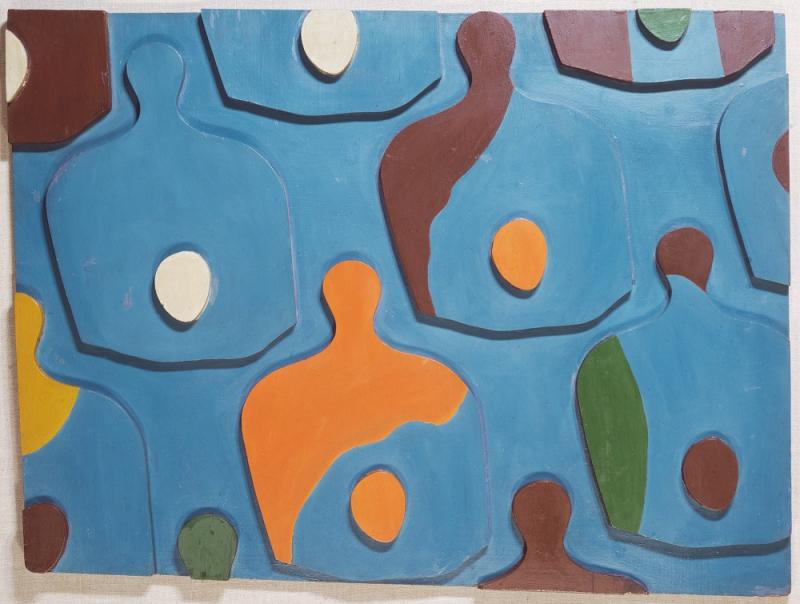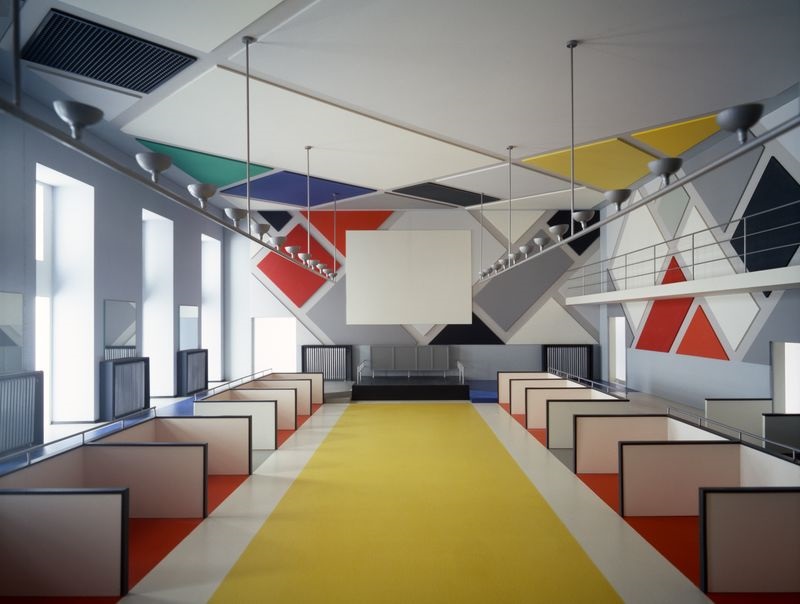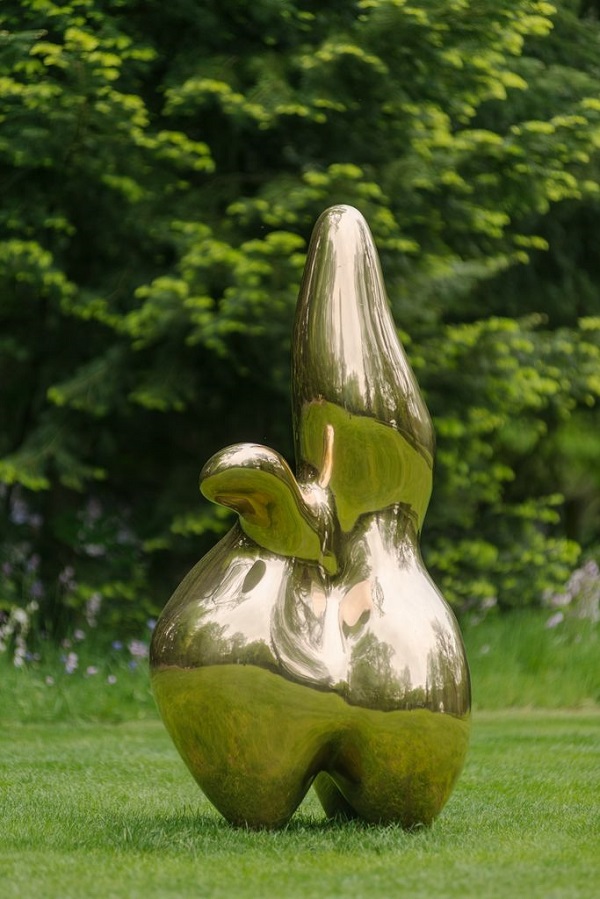Jean Arp: Poetry of Forms review - subversive pioneer honoured in Holland | reviews, news & interviews
Jean Arp: Poetry of Forms review - subversive pioneer honoured in Holland
Jean Arp: Poetry of Forms review - subversive pioneer honoured in Holland
A celebratory retrospective in Otterlo is heading for Margate

This summer the wonderful Kröller-Möller museum in Otterlo hosts the first major Dutch retrospective of the works of Hans (Jean) Arp since 1960 – an exhibition that will travel in a marginally smaller version to Margate’s Turner Contemporary later this year.
In this context, the German-French Arp emerges as a playful and delightfully disruptive figure, who collaborated with some of the leading avant-garde figures of his era, moving through Dada (as a founder member), Abstraction and Surrealism (working with both poets and artists) to pioneer his own "concrete art", and whose extensive close network included De Stijl’s Theo van Doesburg (pictured below: Maquette of the Arbette amusement centre in Strasbourg, which Arp, his wife, and Theo Van Doesburg collaborated on). Arp’s most enduring collaboration was with his first wife and fellow artist Sophie Taeuber, who "through the example of her clear work and her clear life, showed me the right path, the road to beauty", and who is also the inspiration behind much of his creative experimentation (she died tragically in 1943 of carbon monoxide poisoning). If you travel to Otterlo to see Arp, prior to his English seaside outing this autumn, you will find a special section of the exhibition (only in Otterlo) that reconstructs the interior of the Aubette amusement centre in Strasbourg that Sophie Taeuber, Arp and Van Doesburg designed together, together with a blow-up photo of Arp – with a gentle, mischievous intelligence playing around his features – and his wife. You will also be able to view Arp’s collages, reliefs, sculptures, prints, poetry, writings and publications in the context of the Kröller Möller’s world-renowned sculpture garden, where Arp’s Cloud Shepherd, 1953 (pictured below left), has long been one of its most popular residents. This monumental bronze – marking a triumphant new chapter in his late career – shows what a master Arp was of both abstraction and allusion. The sculpture’s bulging organic form might suggest a shepherd with its crook or the homely gait of a sheep, but it is also entirely itself with its own fundamental essence. At the same time it borrows from the curves and marvels of nature, refracting light and reflecting grass, lake and sky.
If you travel to Otterlo to see Arp, prior to his English seaside outing this autumn, you will find a special section of the exhibition (only in Otterlo) that reconstructs the interior of the Aubette amusement centre in Strasbourg that Sophie Taeuber, Arp and Van Doesburg designed together, together with a blow-up photo of Arp – with a gentle, mischievous intelligence playing around his features – and his wife. You will also be able to view Arp’s collages, reliefs, sculptures, prints, poetry, writings and publications in the context of the Kröller Möller’s world-renowned sculpture garden, where Arp’s Cloud Shepherd, 1953 (pictured below left), has long been one of its most popular residents. This monumental bronze – marking a triumphant new chapter in his late career – shows what a master Arp was of both abstraction and allusion. The sculpture’s bulging organic form might suggest a shepherd with its crook or the homely gait of a sheep, but it is also entirely itself with its own fundamental essence. At the same time it borrows from the curves and marvels of nature, refracting light and reflecting grass, lake and sky.
 Arp described art as "a fruit that grows in man, like a fruit on a plant, or a child in its mother’s womb". His work delights in organic curves and abstract shapes, surrealist humour, deep humanity, creative chance and play – whether in written or visual form. The exhibition focuses on the years 1920-35, when Arp set out to create a new relationship between the human, object and nature and when his visual and textual practices co-exist and interplay. His belief that art should never just imitate the natural world but follow its own inherent nature, led to him developing independent biomorphic forms that have their own interior life. Thus we see him progress from paper cut-outs and collage (embracing chance and randomness) through wood reliefs and freestanding flat sculpture (his "stabiles") to his "concretions" (embodiments). The latter present themselves to us as if they are new visual entities. Their smooth free-flowing shapes are born of the same impulses that give rise to clouds, hills, human body parts, as opposed to the machines and institutions that Arp regarded as the engines of war (pictured below: Sculpture to be Lost in the Forest, 1932).
Arp described art as "a fruit that grows in man, like a fruit on a plant, or a child in its mother’s womb". His work delights in organic curves and abstract shapes, surrealist humour, deep humanity, creative chance and play – whether in written or visual form. The exhibition focuses on the years 1920-35, when Arp set out to create a new relationship between the human, object and nature and when his visual and textual practices co-exist and interplay. His belief that art should never just imitate the natural world but follow its own inherent nature, led to him developing independent biomorphic forms that have their own interior life. Thus we see him progress from paper cut-outs and collage (embracing chance and randomness) through wood reliefs and freestanding flat sculpture (his "stabiles") to his "concretions" (embodiments). The latter present themselves to us as if they are new visual entities. Their smooth free-flowing shapes are born of the same impulses that give rise to clouds, hills, human body parts, as opposed to the machines and institutions that Arp regarded as the engines of war (pictured below: Sculpture to be Lost in the Forest, 1932).
In this context, the decision of the exhibition’s designers to encase Arp’s sculptures in large glass vitrines on blocky plinths seems incomprehensible (even though in the first room the blocks are arranged in a sinuous curve). The wall works, too – from the collages and wood reliefs to the exuberant prints – have been framed within large rectangular mounts (the same brown tone as the plinths) giving them a monolithic uniformity that belies Arp’s fluid approach. The rectangular "settings" may mirror some of the few rectilinear compositions or symmetrical woodcuts on display, such as the early Duo-collage of 1918 (made with his wife), but they do the majority of Arp’s works no favours. The catalogue for the show quotes the avant-garde poet Tristan Tzara, whose views are attributed to Arp: "In the same sense as the picture frame prevents direct and immediate emotion, the plinth of the sculpture too is a convention. Realities, creations have neither ends nor feet but are complete in their unity." Unfortunately, this design – which is no doubt intended to provide a cohesive solution to the difficulties of exhibiting the sheer variety of media Arp worked in – will travel with the show. Arp’s work, however, somehow survives this unsympathetic environment. Arp wanted his art to be seen in the context of the workings of nature. His creativity, like the waves of the sea or a body in motion, cannot be confined: it constantly morphs, plays and resolves itself into something that is lively, mysterious, and often inordinately satisfying.
Arp’s work, however, somehow survives this unsympathetic environment. Arp wanted his art to be seen in the context of the workings of nature. His creativity, like the waves of the sea or a body in motion, cannot be confined: it constantly morphs, plays and resolves itself into something that is lively, mysterious, and often inordinately satisfying.
- Arp: The Poetry of Forms at the Kröller-Müller Museum, Otterlo until 17 September 2017 and then at Turner Contemporary, Margate 7 October – 14 January 2018
- Read more visual arts reviews on theartsdesk
rating
Explore topics
Share this article
The future of Arts Journalism
You can stop theartsdesk.com closing!
We urgently need financing to survive. Our fundraising drive has thus far raised £49,000 but we need to reach £100,000 or we will be forced to close. Please contribute here: https://gofund.me/c3f6033d
And if you can forward this information to anyone who might assist, we’d be grateful.

Subscribe to theartsdesk.com
Thank you for continuing to read our work on theartsdesk.com. For unlimited access to every article in its entirety, including our archive of more than 15,000 pieces, we're asking for £5 per month or £40 per year. We feel it's a very good deal, and hope you do too.
To take a subscription now simply click here.
And if you're looking for that extra gift for a friend or family member, why not treat them to a theartsdesk.com gift subscription?
more Visual arts
 'We are bowled over!' Thank you for your messages of love and support
Much-appreciated words of commendation from readers and the cultural community
'We are bowled over!' Thank you for your messages of love and support
Much-appreciated words of commendation from readers and the cultural community
 Kerry James Marshall: The Histories, Royal Academy review - a triumphant celebration of blackness
Room after room of glorious paintings
Kerry James Marshall: The Histories, Royal Academy review - a triumphant celebration of blackness
Room after room of glorious paintings
 Folkestone Triennial 2025 - landscape, seascape, art lovers' escape
Locally rooted festival brings home many but not all global concerns
Folkestone Triennial 2025 - landscape, seascape, art lovers' escape
Locally rooted festival brings home many but not all global concerns
 Sir Brian Clarke (1953-2025) - a personal tribute
Remembering an artist with a gift for the transcendent
Sir Brian Clarke (1953-2025) - a personal tribute
Remembering an artist with a gift for the transcendent
 Emily Kam Kngwarray, Tate Modern review - glimpses of another world
Pictures that are an affirmation of belonging
Emily Kam Kngwarray, Tate Modern review - glimpses of another world
Pictures that are an affirmation of belonging
 Kiefer / Van Gogh, Royal Academy review - a pairing of opposites
Small scale intensity meets large scale melodrama
Kiefer / Van Gogh, Royal Academy review - a pairing of opposites
Small scale intensity meets large scale melodrama
 Jenny Saville: The Anatomy of Painting, National Portrait Gallery review - a protégé losing her way
A brilliant painter in search of a worthwhile subject
Jenny Saville: The Anatomy of Painting, National Portrait Gallery review - a protégé losing her way
A brilliant painter in search of a worthwhile subject
 Abstract Erotic, Courtauld Gallery review - sculpture that is sensuous, funny and subversive
Testing the boundaries of good taste, and winning
Abstract Erotic, Courtauld Gallery review - sculpture that is sensuous, funny and subversive
Testing the boundaries of good taste, and winning
 Edward Burra, Tate Britain review - watercolour made mainstream
Social satire with a nasty bite
Edward Burra, Tate Britain review - watercolour made mainstream
Social satire with a nasty bite
 Ithell Colquhoun, Tate Britain review - revelations of a weird and wonderful world
Emanations from the unconscious
Ithell Colquhoun, Tate Britain review - revelations of a weird and wonderful world
Emanations from the unconscious
 Rachel Jones: Gated Canyons, Dulwich Picture Gallery review - teeth with a real bite
Mouths have never looked so good
Rachel Jones: Gated Canyons, Dulwich Picture Gallery review - teeth with a real bite
Mouths have never looked so good
 Yoshitomo Nara, Hayward Gallery review - sickeningly cute kids
How to make millions out of kitsch
Yoshitomo Nara, Hayward Gallery review - sickeningly cute kids
How to make millions out of kitsch

Add comment